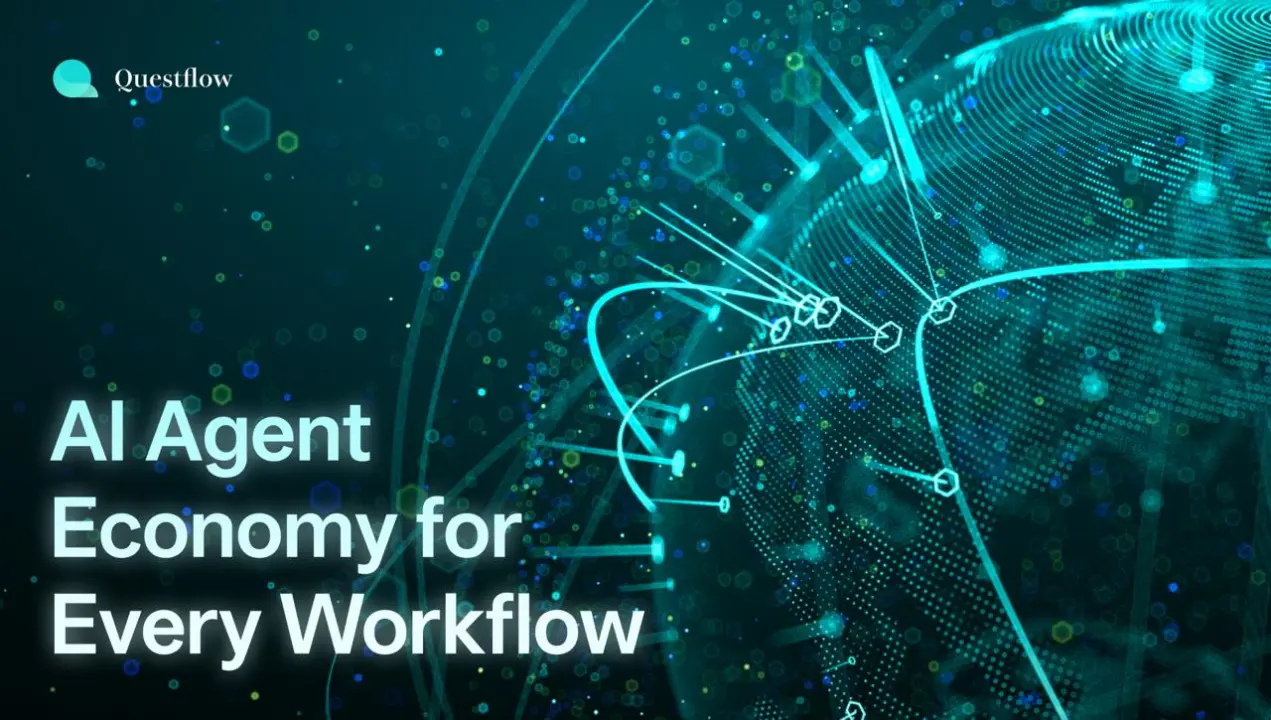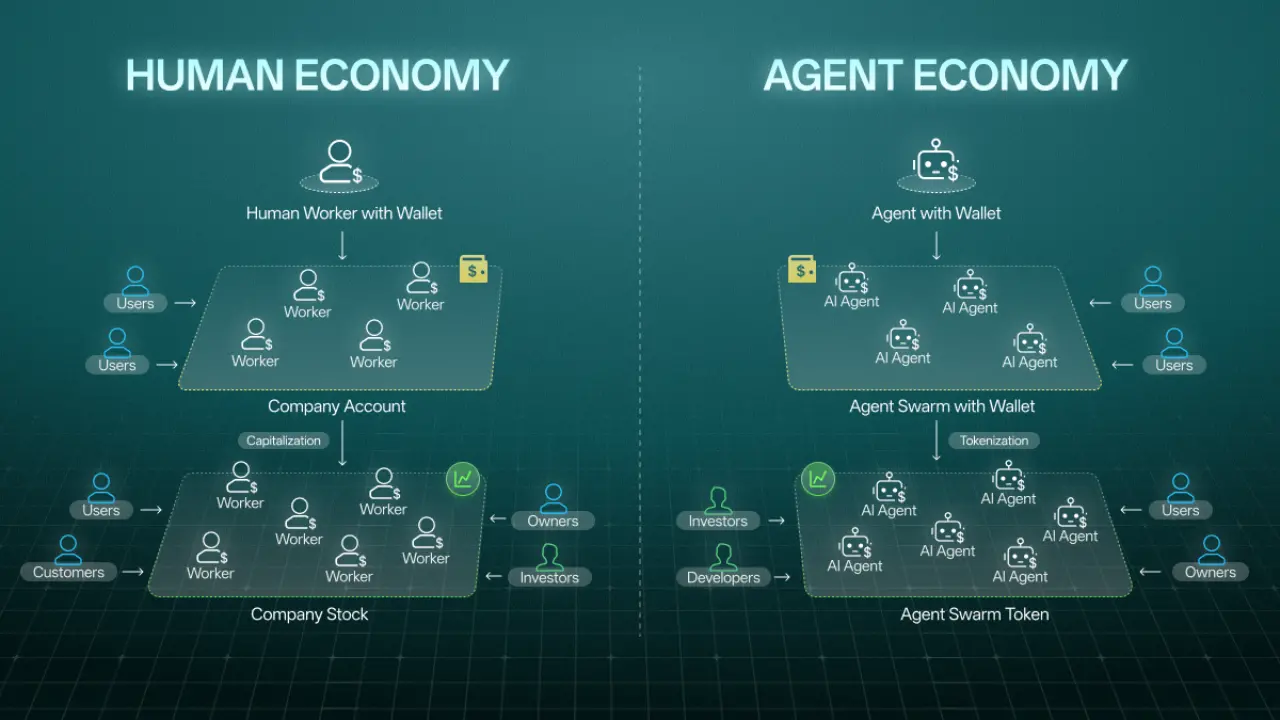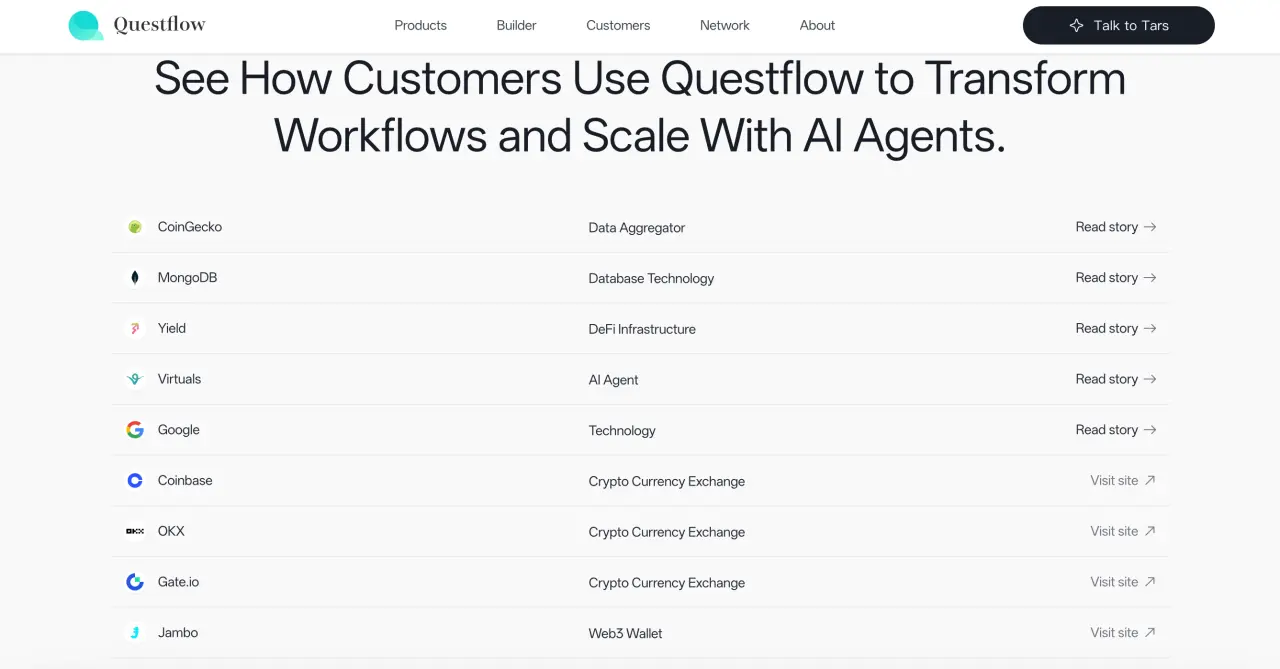Author: momo, ChainCatcher

Recently, the multi-AI agent scheduling platform Questflow announced the completion of a $6.5 million seed round financing, led by CyberFund (an institution under Lido co-founder), with participation from top institutions and projects such as Delphi Labs, Systemic Ventures (supported by Ethereum co-founder Joseph Lubin), Animoca Brands, HashKey Capital, ElizaOS, and received ecological funding from Aptos, Coinbase, Virtuals Protocol, among others.
In July last year, Questflow also secured $1.5 million in angel round financing from Qiji Chuangtan and PAKA.
In addition to receiving investment support from leading institutions and projects, Questflow has recently established strategic partnerships with top Web2 and Web3 platforms such as Circle, Coinbase, Google, Near, and CoinGecko.
Why has Questflow gained favor from leading institutions and projects? What problems does its multi-AI agent scheduling platform solve? In the wave of AI and blockchain integration, how does Questflow position itself in the AI track?
In the Era of AI Agents, Workflows Will Be Restructured

The rise of AI Agents is reshaping traditional work patterns, and collaboration between humans and AI Agents may become the norm in future work.
For individual workers, AI Agents will serve as effective "digital assistants," handling repetitive, procedural tasks such as schedule management, email filtering, and meeting notes. This will free up individual workers' productivity, allowing them to focus on more creative and strategic high-level tasks.
AI Agents will also become "digital employees" for enterprises, helping to reduce costs and increase efficiency. Companies need to establish a pool of AI Agents, deploying specialized Agents for finance, customer service, data analysis, and more, for employees to coordinate scheduling. Employees only need to express their needs, and intent-driven automation can mobilize Agents to execute efficiently, requiring employees only to review key content.
However, there are currently no mature enterprise service solutions in the market to address the workflow revolution brought by AI Agents.
Although there are AI tools like ChatGPT, DeepSeek, and Midjourney available for specific tasks, each model has its own user interface, payment structure, and API syntax, leading to a fragmented user experience.
Moreover, enterprise needs vary widely, and existing general-purpose AI tools are expected to struggle to fully adapt to specific business scenarios. For most employees without a technical background, the future of scheduling and operating multiple AI Agents also presents challenges.
In the era of collaboration between humans and AI Agents, there will be a huge market demand for helping enterprises customize AI Agent functionalities and coordinate multiple AI Agents to handle complex tasks across departments and scenarios.
A report from the Jiazi Guangnian Think Tank predicts that by 2026, 60% of enterprises will deploy AI Agents, and by 2027, 40% of enterprise services will be delivered by combinations of AI Agents.
In this trend, Questflow is committed to building a flexible, composable multi-AI agent scheduling platform, allowing AI Agents to collaborate like employees and helping individuals and enterprises adapt to new workflow models.
How Does Questflow Build the "Intelligent Hub" for Multi-Agent Collaboration?
Questflow acts as the "intelligent hub" in the collaboration process between humans and multiple AI Agents. Based on the MAOP (Multi-Agent Orchestration Protocol), Questflow can understand intent, coordinate various types of AI Agents to take action, and reward AI Agents based on task results and usage metrics through on-chain payments.
While helping workers automate repetitive processes, Questflow also retains the right for human intervention at key points, achieving an "efficient + controllable" workflow collaboration model.
Currently, Questflow's TARS, based on the MAOP protocol, serves as an intelligent hub for multi-Agent collaboration.
Users can express their needs through TARS, which coordinates multiple AI Agents to efficiently collaborate and complete complex tasks through Agent-to-Agent cluster scheduling, ensuring seamless, efficient, and accurate workflows.
For example, if a user needs to browse AI forums like GitHub and Reddit daily and compile a list of AI Alpha projects, they can schedule the GitHub Agent and Reddit Agent through TARS to complete an Agent-to-Agent scheduling process without needing to input code. Subsequently, this cluster responsible for AI Alpha can automatically perform the organization and analysis for the user daily, without manual collection.
TARS also shares three typical daily use cases. For instance, market analysts can use TARS to automate the collection of AI news and trends, obtaining the latest information from collaborations between GitHub Agent, HackerNews Agent, ProductHunt Agent, etc.; content creators can automate video distribution through TARS, publishing content on social media with the collaboration of YouTube Agent, Instagram Agent, and TikTok Agent; and marketing teams can create and manage multi-platform content calendars through TARS, including automated updates and reminders in a multi-Agent interactive collaboration experience.
For some relatively clear and fixed basic tasks, users can almost complete them based on TARS's Agent-to-Agent protocol.
TARS also has built-in payment, Agent wallets, and automatic settlement mechanisms, allowing any one or multiple collaborating AI Agents to handle payment and settlement capabilities based on their work. For example, users can pay on demand using stablecoins like USDC, without needing a monthly subscription.
The flexibility and efficiency of TARS in different task scenarios stem from Questflow's multi-AI agent scheduling protocol and its integration of a multi-dimensional AI model stack, covering multi-dimensional AI collaboration capabilities, including but not limited to:
Video generation models: Veo3, Zora, Runway, Kelin, Jimeng, etc.;
Image generation models: GPT-4o, Flux, Stable Diffusion, MidJourney, Google Imagen4, Artbreeder, Deep dream, etc.;
Deep search models: ChatGPT, Gemini 2.5 pro, Claude, Qwen, etc.
Questflow's advantage lies in ensuring seamless integration between various AI models to adapt to complex scenarios involving multiple tasks. At the same time, large language models like GPT-4o allow users to handle work simply by "expressing their needs." Users do not need to repeatedly switch and log into different AI platforms; they can invoke them through Questflow's unified interface, wallet, and single operation.
If MAOP is the "intelligent center" coordinating multiple agents, then the Questflow Developer Platform (QDP) is the "power engine" driving the construction of a robust labor market.
QDP is dedicated to empowering developers by providing modular SDKs, natural language-driven no-code development tools, and efficient, transparent on-chain settlement capabilities, achieving seamless integration of development, scheduling, and settlement. Developers can quickly encapsulate APIs as AI Agents without dealing with underlying technologies and build AI agent groups to execute complex workflows through orchestration scheduling, while supporting flexible monetization models such as pay-per-use with stablecoins like USDC and revenue sharing.
As the number of AI Agent models on the platform continues to grow, ensuring quality is equally important, as poor quality can affect user experience.
To this end, Questflow has also launched the "Agent Benchmark," which generates dynamic rankings based on a multi-dimensional evaluation system (cost/quality/speed) to recommend the optimal Agent combinations to users and supports instant settlement of testing fees in stablecoins.
Through the collaboration of MAOP, QDP, and Benchmark, Questflow is building a decentralized AI productivity network, allowing agents to truly become composable and tradable production factors.
Co-building with Top Platforms like Coinbase and Circle, Questflow's Growth Potential
Questflow is building key infrastructure for the era of AI Agents through strategic partnerships with top platforms like Coinbase and Circle.
According to official information, Questflow has established partnerships with leading platforms across various fields, including exchanges (Coinbase, OKX, Gate), stablecoins (Circle), data analysis (MongoDB, CoinGecko), AI Agent platforms (Virtuals, Yield), Web3 mobile (Jambo), and Web2 enterprises (Google), among others.

Taking the collaboration with Coinbase as an example, Questflow has engaged in deep cooperation with its developer ecosystem. Questflow utilizes the wallet API from the Coinbase Developer Platform (CDP) to provide on-chain asset management and settlement systems for AI Agents. Questflow's MAOP protocol also integrates CDP's AgentKit for ecological users to call upon.
In the wave of enterprises integrating AI Agents, Questflow has a very high market ceiling. It is not just a functional tool but an ecological-level platform, leveraging the intersection of two trillion-dollar markets: the global enterprise automation service market and decentralized financial infrastructure.
Currently, Questflow's core protocol and products have been recognized by leading institutions. While most AI projects are still competing on single-point technologies, Questflow has completed preliminary practices from technical protocols to commercial ecosystems by binding with leading projects like Circle and Coinbase. It is expected to further expand from the Web3 field into the larger Web2 ecosystem in the future.
Additionally, Questflow's team gene also supports long-term productization and commercialization. As the AI Agent network continues to expand, Questflow is poised to become the App Store of the AI era, managing the flow and distribution of AI Agent economics.
免责声明:本文章仅代表作者个人观点,不代表本平台的立场和观点。本文章仅供信息分享,不构成对任何人的任何投资建议。用户与作者之间的任何争议,与本平台无关。如网页中刊载的文章或图片涉及侵权,请提供相关的权利证明和身份证明发送邮件到support@aicoin.com,本平台相关工作人员将会进行核查。




